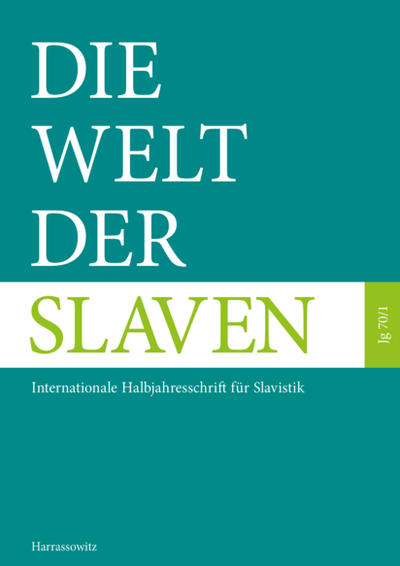Urtext, Überlieferungs- und Wirkungsgeschichte im russischen Donat
Wie und ob sich Gegensätze textkritisch heranziehen lassen
DOI:
https://doi.org/10.13173/WS.70.1.131Schlagwörter:
textual criticism, Donatus, Russian interlinear translation, text reconstruction, textual historyAbstract
Original, history of transmission and impact in the Russian Donat: How and whether contrasts can be analysed text-critically
The manuscript tradition of the Russian Donatus poses a significant challenge for philologists. The recensio codicum has unveiled an intriguing textual transmission, which can be broadly categorized into two primary branches: 1) Some manuscripts, albeit defective (with two of them preserving a bilingual interlinear format), exhibit a rather mechanical copying process of the text; 2) Another branch consists of a single manuscript, which presents a seemingly better text. However, this version is a clearly augmented and interpolated version, reflecting changes made in a later period. A critical comparison between these two recensions not only permits but also necessitates a new editorial approach. This approach should prioritize the legitimate goal of textual restitution while also considering the subsequent history of the text, including its indirect tradition. It is therefore advisable to blend the “classical” method of identifying errors, wherever applicable, with a thorough examination of the text’s evolution as evidenced by the interpolated version.
Literaturhinweise
Danti, Angiolo. 1973–1974. Di un particolare aspetto della tradizione manoscritta antico-russa: Testi a duplice redazione e problemi della loro edizione. Ricerche slavistiche 31. 15–44 [Nachdruck in Danti 1993, 149–173].
Danti, Angiolo. 1993. Fra Slavia orthodoxa e Slavia romana: Studi di ecdotica. Hg. Alda Giambelluca Kossova. Palermo: Lombardi.
Donat. 2002. Der russische Donat: Vom lateinischen Lehrbuch zur russischen Grammatik. Hg. Vittorio Springfield Tomelleri. Köln, Weimar, Wien: Böhlau.
Dostál, Antonín. 1949–1950. K ediční metodice staroslověnských textů. Slavia 19. 28–53.
Henkel, Nikolaus. 1994. Die althochdeutschen Interlinearversionen: Zum sprach- und literaturhistorischen Zeugniswert einer Quellengruppe. In Heinzle, Joachim et al. (Hg.), Übersetzen im Mittelalter: Cambridger Kolloquium 1994, 46–77. Berlin: Erich Schmidt.
Ising, Erika. 1970. Die Herausbildung der Grammatik der Volkssprachen in Mittel- und Osteuropa: Studien über den Einfluß der lateinischen Elementargrammatik des Aelius Donatus De octo partibus orationis ars minor. Berlin: Akademie-Verlag.
Jagič, Ignatij Vikentʹevič (Hg.). 1885–1895. Rassuždenija južnoslavjanskoj i russkoj stariny o cerkovno-slavjanskom jazyke. Sankt-Peterburg: Tipografija Imperatorskoj Akademii Nauk. [Nachdruck des Separatdrucks Berlin 1896, München: Fink 1968.]
Keipert, Helmut. 1989. Deutsches im russischen Donat. Die Welt der Slaven 34(2). 236–258.
Kolesov, Vladimir Viktorovič. 1984. Traces of the medieval Russian language question in the Russian azbukovniki. In Picchio, Riccardo & Goldblatt, Harvey (eds.), Aspects of the Slavic language question, vol. II (East Slavic), 87–123. New Haven: Yale Concilium on International and Areal Studies.
Mordovcev, Daniil Lukič. 1861. O russkich školʹnych knigach XVII veka. Čtenija v Imperatorskom Obščestve istorii i drevnostej rossijskich pri Moskovskom Universitete 4. 1–102.
Pravila. 1999. Die Pravila gramatičnye, der erste syntaktische Traktat in Rußland. Hg. Vittorio Springfield Tomelleri. München: Sagner. DOI: 10.3726/b12258.
Schwenke, Paul. 1903. Die Donat- und Kalendertype: Nachtrag und Übersicht. Mainz: Verlag der Gutenberg-Gesellschaft.
Seiffert, Hans Werner. 2005. Edition (1956/58). In Nutt-Kofoth, Rüdiger (ed.), Dokumente zur Geschichte der neugermanistischen Edition, 162–173. Tübingen: Niemeyer. DOI: 10.1515/9783110926927.162.
Sobolevskij, Aleksej Ivanovič. Perevodnaja literatura Moskovskoj Rusi XIV–XVII vekov: Bibliografičeskie materialy. Sankt-Peterburg: Tipografija Imperatorskoj Akademii Nauk.
Stackmann, Karl. 1997. Mittelalterliche Texte als Aufgabe. In ders., Mittelalterliche Texte als Aufgabe: Kleine Schriften I, Hg. Jens Haustein, 1–25. Göttingen: Vandenhoeck & Ruprecht. [Ursprünglich erschienen in Foerste, William & Borck, Karl Heinz (eds.), Festschrift für Jost Trier zum 70. Geburtstag, 240–267. Köln, Graz: Böhlau.]
Timpanaro, Sebastiano. 1981. Stemmi bipartiti e perturbazioni della tradizione manoscritta. In ders., La genesi del metodo del Lachmann, 2. Aufl, 123–150. Padova: Liviana. [1. Aufl. Firenze: Le Monnier 1963.]
Timpanaro, Sebastiano. 2005. Bipartite stemmas and disturbances of the manuscript tradition. In idem, The genesis of Lachmann’s method (ed. and transl. by Glenn W. Most), 157–187. Chicago, London: University of Chicago Press.
Tomelleri, Vittorio Springfield. 2021. O roli novgorodskoj tradicii latinskich perevodov v istorii russkogo jazyka i kulʹtury: Leksičeskie zaimstvovanija i neosoznannye fragmenty. Vestnik Sankt-Peterburgskogo universiteta: Jazyk i literatura 18(1). 202–219.
Tomelleri, Vittorio Springfield. 2023. Vokrug Donata. Moskva: Indrik.
Tvorogov, Oleg Viktorovič. 2009. Archeografija i tekstologija drevnerusskoj literatury: Kurs lekcij. Moskva, Sankt-Peterburg: Alʹjans-Archeo.
Wimmer, Elke. 2005. Novgorod – ein Tor zum Westen? Die Übersetzungstätigkeit am Hofe des Novgoroder Erzbischofs Gennadij in ihrem historischen Kontext (um 1500). Hamburg: Kovač.
Worth, Dean S. 1983. The origins of Russian grammar: Notes on the state of Russian philology before the advent of printed grammars. Columbus (OH): Slavica.

